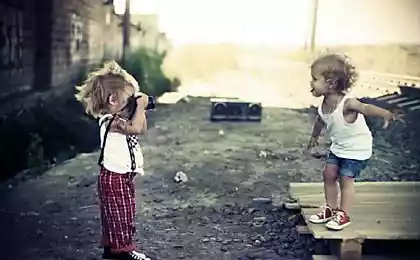245
The most outrageous experiments on children
What if, for the sake of saving humanity, say, cancer requires leaving a few frightened children in the wilderness for a while? Just to satisfy scientific curiosity? Do you think the answer is obvious? Alas, not for everyone. Some scientists don’t see anything wrong with science.
1. Take the kids to the wilderness and set them against each other.

In 1954, a Turkish psychologist, Muzafer Sherif, wondered what would happen if two groups of children were thrown into a remote, deserted place and forced to fight each other?
Sherif knew of no other way to satisfy his scientific curiosity than to experiment, so he recruited two groups of eleven ordinary 11-year-olds each. The children were confident that they were going to a summer campground and anticipated three weeks of serene mountain climbing, fishing and swimming.
None of them could have imagined that their parents had already signed their consent to participate in the Sherif experiment, and that there was another unsuspecting group of peers specially recruited to play with them.
The first week went well as both groups kept separate. This time was spent building relationships within each group. And there and there a certain hierarchy was formed, leaders were found and names were invented - one group wanted to be called "Eagles", another - "Pettlesnakes".
When a “real team” formed from each group, the Eagles and the Serpents were allowed to “accidentally” learn of each other’s existence. The second stage of the experiment began, in which researchers tried to adjust conflict situations, and then watched how far the enmity would go.
It began with innocent games like basketball and tug of war and prizes in the form of penknifes for winners, and resentment for the defeated. The researchers then skillfully expanded and deepened the conflict, and eventually organized a party that Orlov had been brought to a little earlier.
The first arrived with pleasure ate all the most delicious, leaving pitiful scraps to rivals. The snakes were offended and went to call the Eagles. Then came the throwing of plates of food, which eventually turned into a full-blown battle. After that, the children from different groups were enraged every time they saw each other, and each time they tried to arrange some kind of mischief to the opponents.
All in all, Sheriff and his team managed in record time (less than three weeks) to turn ordinary 11-year-olds without behavioral problems into a crowd of aggressive savages. Long live science!
By the way, the Sheriff did such experiments three times, and each time they ended in serious fights.
2. Program your kids into violence and then throw them a clown.
In the early 60s, psychologist Albert Bandura set out to find out whether children tend to imitate aggressive adult behavior. He took a huge inflatable clown doll, which he named Bobo, and made a film as an adult aunt scolds, beats, kicks and even hits him with a hammer. He then showed this video to a group of 24 preschoolers. The second group was shown a video without violence, and the third group was shown nothing at all.
All three groups then alternately launched several hammers and even toy pistols into a room where Bobo was a clown, although none of the videos showed any firearms.
The children who watched the aggressive video wasted no time in torturing poor Bobo:
One boy put a gun to the clown's head and whispered something about how he would gladly blow his brains out:
In the other two groups, there was not even a hint of violence.
After Bandura presented his findings to the scientific community, there were many skeptics who said that all this proves nothing, since the rubber doll was invented to kick it.
Then Bandura made a film with the abuse of a living adult, dressed as a clown, then gathered more children, showed them his netlenka and again launched into the room to (now alive!) Bobo. As many of you may have guessed without any experiment, the children began to insult, kick and beat a live clown with the same zeal as the first time.
This time, Bandura’s claim that children imitate adult behavior was not disputed.
3. Experiment with a broken doll
Psychologists at the University of Iowa decided to find out how babies feel guilty. To do this, they conducted an experiment called the Broken Doll.
The adult showed the child the toy and told a touching story about how special it was, how much he connected with it and how he loved it when he was very young. He then gave the toy to the child, telling them to be very, very careful.
As soon as the toy was in the hands of children, it "breaks" in the most terrible and hopeless way - a special mechanism was arranged for this. The adult, according to the instructions, had to take a deep breath and sit, silently staring at the baby for a minute.
Just imagine a child sitting in the silence of the grave under your reproached gaze, shrivelling, hiding his eyes, covering his head with his hands. A minute stretching to infinity.
Curiously, the children who seemed traumatized by the broken doll experiment the most, behaved much more exemplaryly over the next five years. Maybe the experiment did teach them a healthy sense of guilt. Or maybe these children learned from an early age that any setup can be expected from adults.
4. Cheating a baby
As soon as young children begin to crawl, they immediately understand that you should not climb down steep surfaces, because you can fall and hurt yourself. But how do they know they will fall if they have never fallen?
The study of this phenomenon, according to scientists from Cornell University Eleanor Gibson and Richard Walk, was unthinkable without pushing the infant to the edge of the “terrible abyss” and convincing them to crawl further.
They made the so-called “visual cliff” – a clever design of shields placed on top of thick glass. Then all this was disguised with the help of fabric with the appropriate pattern. As a result, there was a complete illusion that in place of glass there was an empty space up to the floor. It would seem that there is no real danger to the crumbs.
Of course, this experiment did not represent physical harm to the child. But...
Children were pushed one by one to the edge of the cliff, and mothers on the other hand tried to convince them to crawl over the glass. In other words, they recruited mothers somewhere who tried to persuade their crumbs to do what they believed (and rightly did) was certain death. And babies had to choose between obedience and self-preservation.
Thus, 36 children aged 6 to 14 months were tested. Only three of them crawled on the glass. Most turned and crawled away from their mothers. The others started crying.
Despite the fact that most children did not fall for the bait of the experimenters, they were still too close to the edge of the “cliff” and in a real situation could easily fall. This allowed Gibson and Walk to make the "sensational" conclusion that "children should not be left at the edge, no matter how well they can determine depth."
Who would have thought!
5. Use orphans to train expectant mothers
This was back in the days when girls were sent to schools only to learn how to cook, please their husband and run the house.
Someone came up with a “brilliant” idea – to prepare teenage girls to be mothers with the help of live benefits. That is, real children left orphans.
Beginning around 1920, these institutions began to “borrow” hundreds of children from orphanages, on which their young pupils could practice. The children were kept in special classrooms, where groups of 8-12 “moms” were launched during classes.
The real names of the children were kept secret, so the girls came up with nicknames, sometimes quite mocking. After a year or two of work, “visual aids” were attached to foster families.
The program lasted until the 1960s.
6. Turn a disfigured penis into a lifelong experiment

David Reimer, like his twin brother, was born in 1965 in Winnipeg, Canada. When he was eight months old, his parents brought him to the doctor for circumcision. Instead of a scalpel, the doctor for some reason decided to use an electric cauter (an electric cauterization device; approx. mixstuff.ru). In the process, David accidentally burned his penis.
The grief-stricken parents went for advice from psychologist Dr. John Money, who specialized in the study of sexual identity. Dr. Money’s recommendation was to have sex reassignment surgery and raise David as a girl.
Parents who were willing to do everything possible to see their children happy followed the advice of a respected doctor. But, as it turned out much later, the quality of life of the child worried Mani in the last place. The doctor simply did not want to miss the perfect chance to conduct a scientific experiment, which was to “prove that upbringing, and not nature, determines a person’s gender identity and sexual orientation.” And the fact that David had a twin brother offered, according to Money, a unique opportunity to confirm this hypothesis.
The problem was that David never agreed to become Brenda. Brenda refused to wear dresses and preferred to play with cars and pistols of her brother, paying no attention to her own dolls. She was constantly teased at school for talking and acting like a boy.
Desperate parents of Brenda/David went to Dr. Money again, but he convinced them that the child is just a “difficult age” and soon everything will get better. All this time, Mani published scientific articles about his experiment, which he considered his complete and absolute scientific triumph.
And when David grew up and learned the truth, Dr. Money suddenly curtailed the work and stopped publishing. For decades, nothing has been heard of him. It was only in 1997 that documents surfaced from the archives showing the catastrophic damage he had done to poor David.
source:mixstuff.ru
Source: /users/60
How to lower hemoglobin folk remedies
The Voynich manuscript—the most mysterious book in the world, remains a mystery for 500 years























